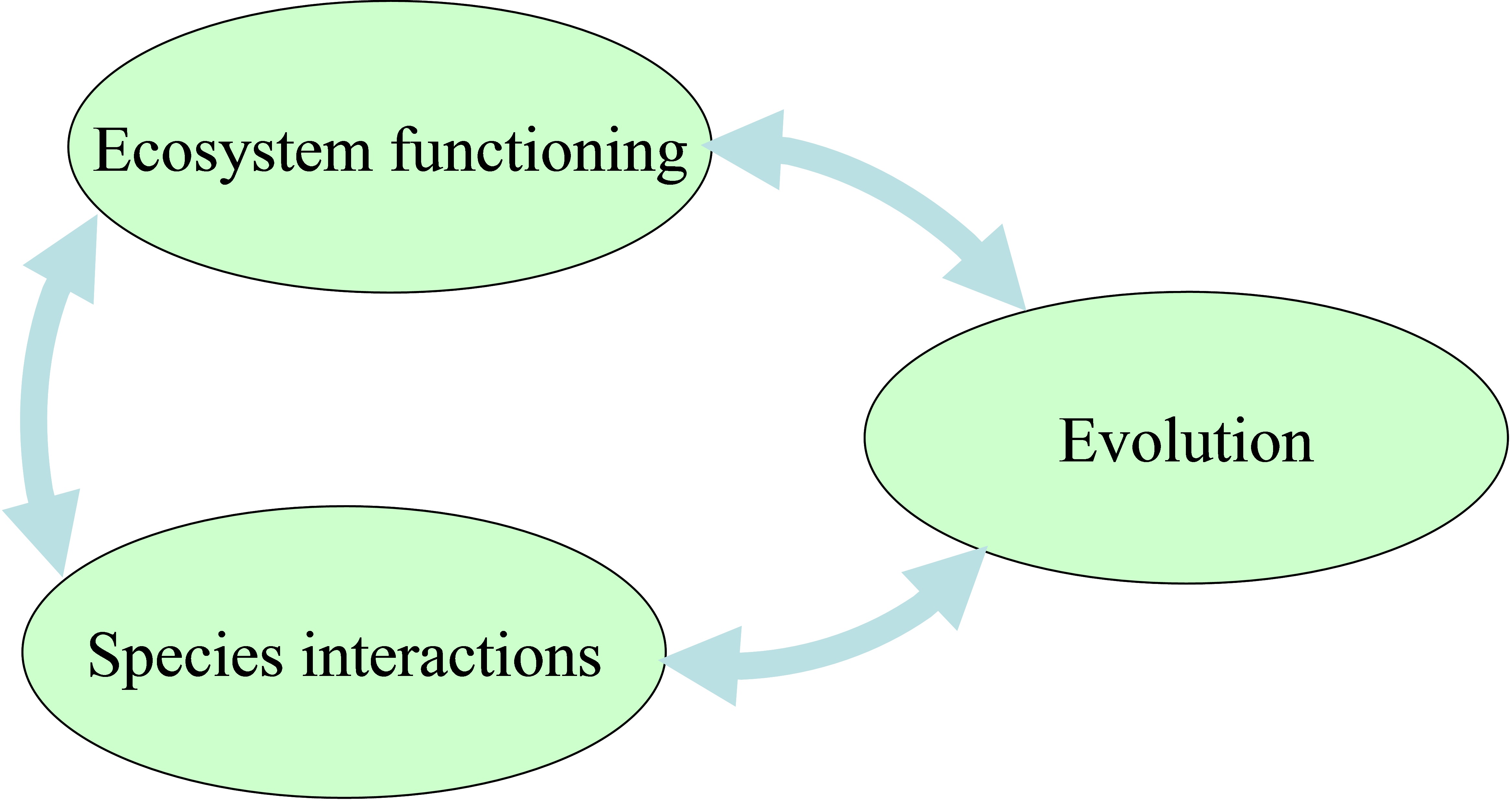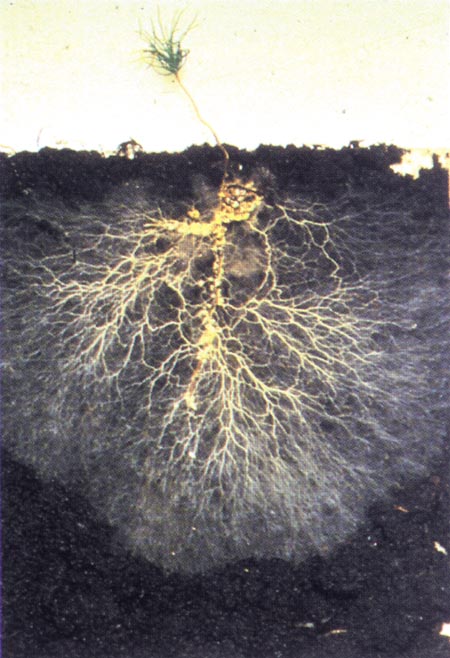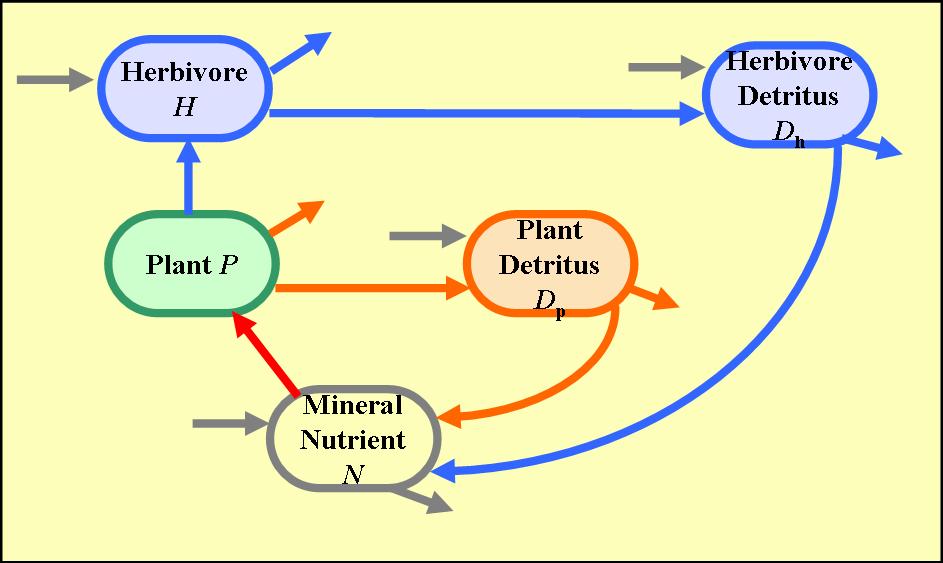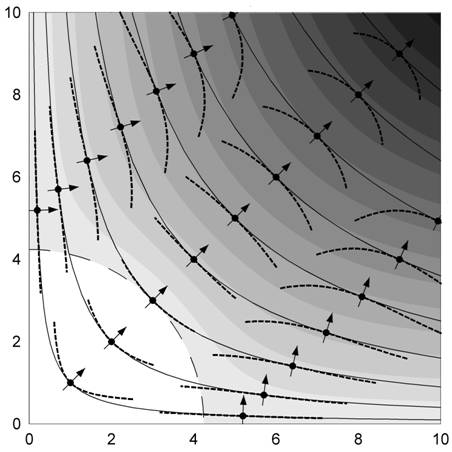RESEARCH INTERESTS
My work aims at predicting the effects of biodiversity loss and other global changes on ecosystem functioning. I generate theoretical predictions of ecosystem functioning depending on component species, their diversity, their ecological interactions, as well as their evolutionary dynamics.
Biodiversity – Stability
With global changes, ecosystem functioning might become less predictable. Several experiments have shown that biodiversity enhances the temporal stability of vegetation biomass. Stability is a key aspect of ecosystem services. I am developing a theory that fosters our understanding of the mechanisms through which biodiversity stabilises communities, to predict community stability from measurable traits of its component species, and that can be applied to experimental and observational data.

Figure : my theory can be applied to data from large biodiversity experiments such as David Tilman’s in Cedar Creek (Minnesota, USA)
Evolution and ecosystem functioning
I am interested in the reciprocal effects of evolutionary dynamics and species interactions on ecosystem functioning. For example, rapid evolutionary dynamics of a predator might enable coexistence of several preys; competitors might slow down adaptation to environmental change.

Figure : Integration of sub-disciplines in ecology is a key feature of the theoretical ecology developed in the Centre.
Mutualism theory
Where do mutualisms come from, how do they evolve?
Do they evolve from exploitative interactions? Could some plants benefit from herbivory? What is a mutualism? In any mutualism, I argue that a benefit can simply be due to evolved dependence, the adaptation to a partner. The organism has evolved a dependence so that it is not able to function without its partner anymore. This could be the case for some plants adapted to herbivory, and is likely to be the case in any mutualistic interaction with a long evolutionary history.
Could some mutualism come from competitive interactions? I developed a theory of the evolution of a trading mutualism for two essential resources, between two competitors, that could apply to plants and their mycorrhizae.

Figure : did the trading mutualism between plants and their mycorrhizae evolve from a competitive interaction?
Nutrient cycling and primary production : the Input-Output Theory.
I developed a new theory of the effect of nutrient cycling on primary production: the Input-Output theory. It defines the conditions for herbivores to increase primary production through nutrient cycling, and can be applied to litter quality.

Figure : Simplified ecosystem model representing the cycle of a limiting nutrient such as nitrogen.
Evolutionary dynamics depending on trade-off geometry.
An organism cannot do everything at the same time. This is the basics of trade-offs that enable biodiversity. Trade-offs are really difficult to measure and their shapes are often unknown. I developed a method to evaluate all possible outcomes of evolutionary dynamics for all possible trade-off shapes, when there is a trade-off between two continuous traits.
de Mazancourt, C., and Dieckmann, U. 2004. Trade-off geometries and frequency-dependent selection. American Naturalist. 164: 765-778.
Mathematica file with codes for figure 3C and 4C of de Mazancourt and Dieckmann (2004). The code was written to be easily used with other equations. Download.

Figure : The evolutionary landscape defines all possible evolutionary outcomes in the space of two continuous traits, where the two traits are constrained by a trade-off of unknown shape.
SUMMARY C.V.
PUBLICATIONS
Barragan-Jason, G., Loreau, M., de Mazancourt, C., Singer, M. C. & Parmesan, C.
(2023) - Psychological and physical connections with nature improve both human well-being and nature conservation : a systematic review of meta-analyses - Biological Conservation 277: 109842Loreau, M., Cardinale, B. J., Isbell, F., Newbold, T., O’Connor, M. I. & de Mazancourt, C.
(2022) - Do not downplay biodiversity loss - Nature 601: E27-E28Barragan-Jason, G., de Mazancourt, C., Parmesan, C., Singer, M. C. & Loreau, M.
(2022) - Human-nature connectedness as a pathway to sustainability: a global meta-analysis - Conservation LettersWang, S., Loreau, M., de Mazancourt, C., Isbell, F., Beierkuhnlein, C., Connolly, J., Deutschman, D. H., Doležal, J., Eisenhauer, N., Hector, A., Jentsch, A., Kreyling, J., Lanta, V., Lepš, J., Polley, H. W., Reich, P. B., van Ruijven, J., Schmid, B., Tilman, D., Wilsey, B. & Craven, D.
(2021) - Biotic homogenization destabilizes ecosystem functioning by decreasing spatial asynchrony - Ecology 102: e03332Galiana, N., Arnoldi, J.-F., Barbier, M., Acloque, A., de Mazancourt, C. & Loreau, M.
(2021) - Can biomass distribution across trophic levels predict trophic cascades? - Ecology Letters 24: 464-476Barbier M., de Mazancourt C., Loreau M., Bunin G.
(2021) - Fingerprints of high-dimensional coexistence in complex ecosystems - Physical Review X 11: 011009Clark, A. T., Arnoldi, J.-F., Zelnik, Y. R., Barabas, G., Hodapp, D., Karakoç, C., König, S., Radchuk, V., Donohue, I., Huth, A., Jacquet, C., de Mazancourt, C., Mentges, A., Nothaaß, D., Shoemaker, L. G., Taubert, F., Wiegand, T., Wang, S., Chase, J. M., Loreau, M. & Harpole, S.
(2021) - General statistical scaling laws for stability in ecological systems - Ecology Letters 24 : 1474-1486.Montoya, D., Haegeman, B., Gaba, S., de Mazancourt, C. & Loreau, M.
(2021) - Habitat fragmentation and food security in crop pollination systems - Journal of Ecology 109: 2991-3006. Barragan-Jason G., de Mazancourt C., Parmesan C., Singer M., Loreau M.
Thompson, P. L., Kéfi, S., Zelnik, Y. R., Dee, L. E., Wang, S., de Mazancourt, C., Loreau, M. & Gonzalez, A.
(2021) - Scaling up biodiversity-ecosystem functioning relationships: the role of environmental heterogeneity in space and time - Proceedings of the Royal Society B 288: 20202779Hammond M., Loreau M., de Mazancourt C. & Kolasa J.
(2020) - Disentangling local, metapopulation and cross-community sources of stabilization and asynchrony in metacommunities. - Ecosphere 11: e03078Montoya D., Gaba S., de Mazancourt C., Bretagnolle V. & Loreau M.
(2020) - Reconciling biodiversity conservation, food production and farmers’ demand in agricultural landscapes. - Ecological Modelling 416: 108889Rotter P., Loreau M. & de Mazancourt C.,
(2020) - Why do forests respond differently to nitrogen deposition? A modelling approach. - Ecological Modelling 425: 109034Montoya D., Gaba S., de Mazancourt C., Bretagnolle V. & Loreau M.
(2019) - Reconciling biodiversity conservation, food production and farmers’ demand in agricultural landscapes. - Ecological Modelling 416: 108889Montoya D., Haegeman B., Gaba S., De Mazancourt C., Bretagnolle V. & Loreau M.
(2019) - Trade-offs in the provisioning and stability of ecosystem services in Agroecosystems. - Ecological Applications 29(2): e01853Montoya D., Haegeman B., Gaba S., De Mazancourt C., Bretagnolle V. and Loreau M.
(2018) - Trade-offs in provisioning and stability of multiple ecosystem services in agroecosystems - bioRxiv doi:10.1101/350967Wang S., Loreau M., Arnoldi J.-F., Fang J., Abd Rahman A., Tao S. & de Mazancourt C.
(2017) - An invariability-area relationship sheds new light on the spatial scaling of ecological stability. - Nature Communications 8: 15211Lafuite A.-S., de Mazancourt C. & Loreau M.
(2017) - Delayed behavioural shifts undermine the sustainability of social–ecological systems. - Proceedings of the Royal Society B. 284 : 20171192Tredennick A.T., de Mazancourt C., Loreau M. & Adler P.B.
(2017) - Environmental responses, not species interactions, determine synchrony of dominant species in semiarid grasslands - Ecology 98(4): 971-981Mellard J.P., de Mazancourt C. & Loreau M.
(2015) - Evolutionary responses to environmental change: trophic interactions affect adaptation and persistence. - Proceedings of the Royal Society of London Series B- Biological Sciences 282: 20141351Wolkovich E.M., Allesina S., Cottingham K.L., Moore J.C., Sandin S.A. & de Mazancourt C.
(2014) - Linking the green and brown worlds: the prevalence and effect of multi-channel feeding in food webs. - Ecology 95: 3376–3386Vasseur D.A., Fox J.W., Gonzalez A., Adrian R., Beisner B.E., Helmus M.R., Johnson C., Kratina P., Kremer C., de Mazancourt C., Miller E., Nelson W.A., Paterson M., Rusak J.A., Shurin J. & Steiner C.F.
(2014) - Synchronous dynamics of zooplankton competitors prevail in temperate lake ecosystems. - Proceedings of the Royal Society of London Series B- Biological Sciences 281: 20140633Morin X., Fahse L., de Mazancourt C., Scherer-Lorenzen M. & Bugmann H.
(2014) - Temporal stability in forest productivity increases with tree diversity due to asynchrony in species dynamics. - Ecology Letters 12: 1526-1535Loreau M. & de Mazancourt C.
(2013) - Biodiversity and ecosystem stability: a synthesis of underlying mechanisms. - Ecology Letters 16, Supplement 1: 106–115de Mazancourt C., Isbell F., Larocque A., Berendse F., De Luca F., Grace J.B., Haegeman B., Polley H.W. Roscher C., Schmid B. Tilman D., van Ruijven J., Weigelt A., Wilsey B.J. & Loreau M.
(2013) - Predicting ecosystem stability from community composition and biodiversity. - Ecology Letters 16: 617–625
